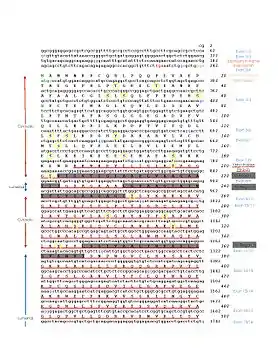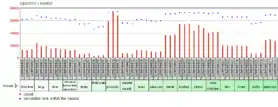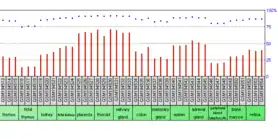TMCO4
Transmembrane and coiled-coil domains 4, TMCO4, is a protein in humans that is encoded by the TMCO4 gene. Currently, its function is not well defined. It is transmembrane protein that is predicted to cross the endoplasmic reticulum membrane three times. TMCO4 interacts with other proteins known to play a role in cancer development, hinting at a possible role in the disease of cancer.
Gene

TMCO4 is located on the minus strand of the first chromosome at 1p36.13.[2] The gene consists of 118,172 base pairs stretching from base pair 19,682,213 through 19,800,385.[2] There are no common aliases for TMCO4. Genes CAPZB and LOC105376823 neighbor TMCO4 on chromosome 1.[1] TMCO4 consists of 16 exons.[1]
mRNA
There are twenty mRNA transcript variants (X1-X20) produced through different combinations of sixteen different exons.[3] The most common variant is X1, which includes all exons and spans the entire 118,172 base pairs.[1]
Protein


Primary sequence
The most common protein encoded by TMCO4 is 634 amino acids in length with accession number XP_011539488.1.[2]
General properties and composition
The molecular weight of TMCO4 is 67.9 kiloDaltons. The isoelectric point is 5.48. As a whole protein, TMCO4 does not have abnormal amino acid distributions. It does have three long stretches of no charge that correspond with the location of the three different transmembrane regions. The first cytosolic domain of TMCO4 does have abnormally high amounts of leucine and glutamic acid and abnormally low amounts of asparagine. The larger lumenal domain of TMCO4 also has an abnormally low amount of asparagine and phenylalanine.

Protein features
Two main areas of interest within the TMCO4 protein are the three transmembrane regions and the large Abhydrolase region.[4] The N-terminus of TMCO4 is predicted to be within the cytosol of the cell, and the C-terminus is predicted to be within the lumen of the endoplasmic retiticulum. TMCO4 is also predicted to have a leucine zipper and a large coiled coil domain.[5]
Secondary structure
The secondary structure of TMCO4 is predicted to be dominated by alpha helices based on predictions by iTASSER software.[6]
Post-translational modifications
Many phosphorylation sites were predicted for the two cytosolic regions of TMCO4.[7] O-linked glycosylation sites were predicted to occur in the end of the second lumenal region of TMCO4.[8] These predicted sites can be seen on both the schematic illustration of TMCO4 found above, or in the conceptual translation of TMCO4 found below.
Subcellular localization
TMCO4 is consistently predicted to be located in the endoplasmic reticulum membrane across many homologs.[5]

| Organism | Common Name | Endoplasmic Reticulum | Golgi | Mitochondrial | Nuclear | Plasma Membrane |
| Homo sapien | Human | 44.4% | 22.2% | 22.2% | 11.1% | - |
| Mus musculis | Mouse | 39.1% | 4.3% | 17.4% | 8.7% | 21.7% |
| Xenopus laevis | Frog | 55.6% | - | 22.2% | 11.1% | - |
| Danio rerio | Zebra fish | 33.3% | 11.1% | 11.1% | - | 22.2% |
| Callorhinchus milii | Australian Ghostshark | 33.3% | 11.1% | 33.3% | - | 22.2% |
Interacting proteins
TMCO4 has been found to interact with many proteins. One protein of interest that TMCO4 interacts with is FLT1.[9] FLT1 is a VEGF receptor[10]. VEGF is known to play a significant role in cancer development. Other proteins that TMCO4 has been experimentally shown to interact with are UBB, UBC, KPTN, and BVLF1.[9] UBB and UBC are polyubiquitins that target molecules for degradation, suggesting that TMCO4 is degraded at some point.[11][12] KPTN is a protein that is essential in neuromorphogenesis.[13] BVLF1 is an Epstein-Barr virus protein.[14]
Homology
Paralogs
TMCO4 does not have any paralogs.
Orthologs
Orthologs to TMCO4 can be found in bacteria, protists, plants, fungi, trichoplax, invertebrates, fish, amphibians, reptiles, birds and mammals.[15] Some of these orthologs can be found in the table below.[15] The orthologs are sorted in descending order of date of evolution from humans and then descending order of percent sequence identity. TMCO4 is a fast evolving gene that has been highly conserved throughout evolution.[15] Regions of TMCO4 that are highly conserved across the orthologs include the various transmembrane domains and the abhydrolase region.
| Genus and species | Accession number | Sequence length | Sequence identity | Sequence similarity |
| Homo sapiens (Human) | NP_859070.3 | 634 | 100% | 100% |
| Papio anubus (Baboon) | XP_017813266.1 | 568 | 96% | 97% |
| Mus musculus (Mouse) | AAH13471.1 | 631 | 83% | 88% |
| Ursus maritimus (Polar Bear) | XP_008692882.1 | 608 | 87% | 90% |
| Gavia stellata (Red-throated loon) | XP_009808720.1 | 610 | 78% | 87% |
| Python bivittatus (Burmese python) | XP_007441490.1 | 617 | 70% | 83% |
| Xenopus laevis (Frog) | XP_018083828.1 | 635 | 75% | 87% |
| Danio rerio (Zebra fish) | XP_003201275.2 | 688 | 59% | 74% |
| Parasteatoda tepidariorum (Spider) | XP_015925328.1 | 642 | 56% | 74% |
| Caenorhabditis elegans | NP_494812.2 | 617 | 42% | 59% |
| Trichoplax adhaerens | XP_002107886.1 | 378 | 52% | 70% |
| Aspergillus clavatus | XP_001275560.1 | 686 | 40% | 58% |
| Vibrio parahaemolyticus | WP_069539226.1 | 412 | 28% | 48% |
Expression


TMCO4 is highly expressed in many tissues. Highest expression occurs within the prostate, trachea, uterus, small intestine, placenta, thyroid, salivary gland, and adrenal gland. Expression of TMCO4 is predicted to be controlled by many transcription factors.
Clinical Significance
TMCO4 is not currently directly linked to any disease or phenotype. However, interacting with a VEGF receptor may be indicative of a possible role in cancer.
References
- "TMCO4 transmembrane and coiled-coil domains 4 [Homo sapiens (human)] - Gene - NCBI". www.ncbi.nlm.nih.gov. Retrieved 2017-05-06.
- Database, GeneCards Human Gene. "TMCO4 Gene - GeneCards | TMCO4 Protein | TMCO4 Antibody". www.genecards.org. Retrieved 2017-02-18.
- [email protected], Danielle Thierry-Mieg and Jean Thierry-Mieg, NCBI/NLM/NIH. "AceView: Gene:TMCO4, a comprehensive annotation of human, mouse and worm genes with mRNAs or ESTsAceView". www.ncbi.nlm.nih.gov. Retrieved 2017-02-18.
- "transmembrane and coiled-coil domain-containing protein 4 [Homo sapien - Protein - NCBI". www.ncbi.nlm.nih.gov. Retrieved 2017-02-18.
- "PSORT II Prediction". psort.hgc.jp. Retrieved 2017-05-06.
- "I-TASSER server for protein structure and function prediction". zhanglab.ccmb.med.umich.edu. Retrieved 2017-05-06.
- "NetPhos 3.1 Server". www.cbs.dtu.dk. Retrieved 2017-05-06.
- "NetOGlyc 4.0 Server". www.cbs.dtu.dk. Retrieved 2017-05-06.
- "STRING: functional protein association networks". string-db.org. Retrieved 2017-05-06.
- "FLT1 - Vascular endothelial growth factor receptor 1 precursor - Homo sapiens (Human) - FLT1 gene & protein". www.uniprot.org. Retrieved 2017-05-06.
- "UBC - Polyubiquitin-C precursor - Homo sapiens (Human) - UBC gene & protein". www.uniprot.org. Retrieved 2017-05-06.
- "UBB - Polyubiquitin-B precursor - Homo sapiens (Human) - UBB gene & protein". www.uniprot.org. Retrieved 2017-05-06.
- "KPTN - Kaptin - Homo sapiens (Human) - KPTN gene & protein". www.uniprot.org. Retrieved 2017-05-06.
- "BVLF1 - BVLF1 - Epstein-Barr virus (strain GD1) (HHV-4) - BVLF1 gene & protein". www.uniprot.org. Retrieved 2017-05-06.
- "Protein BLAST: search protein databases using a protein query". blast.ncbi.nlm.nih.gov. Retrieved 2017-05-06.